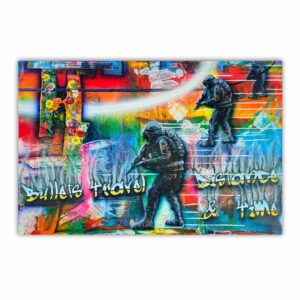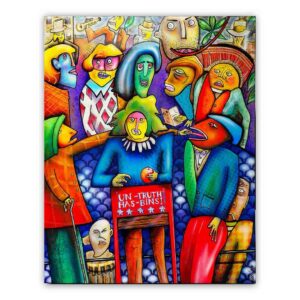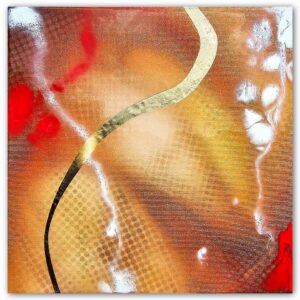- [email protected]
- +353 (0)86 224 0139
- Free Shipping Worldwide
Influence of Cultural Identity on North Americas Art
Does Cultural Identity Influence the Creation of Art? In the fifth region of this series, we explore the heterogeneous society of North America.
Reading Time: 15 minutes
TL;DR
- Read about North American art’s intriguing fusion of many cultures, where centuries-old traditions intertwine with contemporary expressions, prompting thinking and inspiring conversation.
- Discover the secret narratives weaved throughout North American art, where cultural identity informs every brushstroke and sculptural form. From indigenous inspirations to immigrant stories, each piece depicts the richness of a collective heritage, providing insight into the complex relationship between art and identity.
- Engage in art that transcends boundaries, time, and expectations. Allow the exciting examination of cultural identity in North American art to challenge your views, excite your senses, and pique your interest.
- Learn how my art embraces this narrative, inviting you to embrace your own path of self-discovery and appreciation for the transformational power of art.
10 Ways Cultural Identity Has Influenced North Americas Art
We all have unique ways of expressing ourselves, our emotions, and our beliefs. The majority of us do it casually, while others use their creative side, which includes music, writing, and art. In some form or another, art has always been an important part of human existence, and different cultures have done the same.
The symbiotic relationship between North Americas art and its cultural identity has been extremely significant since the dawn of art in the world, as it has aided in self-expression in a world that is keen on suppressing it. History is replete with examples of artists who used art to express themselves and their cultural identity, ranging from Diego Rivera to Abanindranath Tagore.
We know cultural identity influences art, but to what extent? Is it only a contributing factor, or does it drive the entire motivation behind a particular piece of art, be it conscious or subconscious?
Now more than ever, we as individuals are using art to figure out ourselves and our cultural identities, making it a powerful aid in both cultural and various art movements. Artists create art on the basis of their lived experiences. These experiences end up being expressed on the canvas, be it consciously or subconsciously, and they won’t even necessarily be aware of it.
People usually signify art by displaying it on their walls for ornamental purposes and to please the eye but is there more to it than that?
Art is born out of everyday experiences and serves as a necessary form of self-expression. This in itself makes art, not just a pretty picture on a canvas but a reflection of an artist and their vulnerability. An intrinsic relationship exists between art, cultural identity, and lived experiences. This fact alone makes this artwork mean so much more and worthy of an investigation.
An Expression of The Community
What gives you as a community a forum to express yourself? There are many communities and cultures, especially African American artists, that, over the years, have felt underrepresented and in need of recognition. One way of doing that is by using art as an aid to express yourself.
Self-expression in the form of art gives you an insight into an artist’s life and ethnic background. It reflects the community to which the artist belongs. This interpretation of art paves the way for recognising and preserving the cultural identity and the community for the times to come.
What may feel like just a piece of art to you or others may just be a reflection of who they are to an artist and the community.
Artists usually explore the attributes that make up our self and social identity. They create a sense of who we are as individuals, as a society, and as a nation. They question the stereotypes while voicing their concerns for their race, gender, nationality, sexuality, and heritage and demand change in their own unparalleled way.
Culture is an amalgamation of social endeavours, style, music, technology, politics, performance, and the arts, and we as artists try to portray just these things in our art.
Cultural practises in art that embody cultural values make the people heard and recognised, giving them a sense of citizenship and mental peace. This helps contribute to an individual and collective sense of identity.
It is a self-affirmation practise that helps us to interpret, reflect on, add to, or challenge our cultural beliefs.
“It's not who you are that holds you back, it's who you think you're not.”
Jean-Michel Basquiat
How Cultural Identity Melds With North American Art
Indigenous visual arts span thousands of years across America. The primary role of indigenous artists is to evoke an emotional response in their audience. In Native American cultures, the artist’s ability to communicate is largely dependent upon the recognition of the force of tradition.
However, before the Europeans discovered the ‘new world,’ Native American Art was entirely unknown. In North America, Nampeyó, the famous Hopi Potter, María Martínez, and Julián Martínez are perhaps some of the most notable artists with impressive careers.
Through sheer talent, these individuals accomplished a personal triumph by developing a style that was not only copied by other artists but, in time, was also regarded as ‘traditional’ in their particular village.
North American artists now create art more freely through their everyday experiences. Establishing self-identity is vital within minority groups searching for their cultural identity in a deep and rich heterogeneous society.
We are now inspired to look for a deeper meaning and broader participation in artistic work because of various psycho-social reasons that they identify with. We are currently navigating our artistic skills to explore our sense of self, cultural identity, and gender issues, which are largely based on our lived experiences.
These artists have broken away from traditional cultural expectations and are overcoming social barriers. These artists are worthy of investigation since they are culturally motivated expressions of multifaceted experiences in our society.
1. Stereotypes Persevering in the Community
Stereotypes persist when addressing Native American arts and cultures, and sorrowfully, many people remain ignorant of the complex and engaging stories of Native peoples and their art. Too many people still assume a combatant or chief on horseback bearing a feathered headdress or a lovely young “princess” in an animal hide dress.
Popular culture and movies immortalise these images. They homogenise the unimaginable multifariousness of Native groups across North America. There are too many diverse languages, cultural beliefs, cosmologies, and ritual traditions to appropriately make general comments about the cultures and languages of the indigenous communities of what is now the United States and Canada.
2. The Portrayal of the Communities
For many years, the term primitive has been used to define the art of Native families and First Nations. This word is very problematic, and shows the distorted spectacles of colonialism through which these organizations have been seen and misinterpreted. After meeting, Europeans and Euro-Americans often considered the Amerindian peoples of North America as gentle savages.
This legacy has influenced the acceptance and recognition of Native arts, which is why much of it was originally collected by anthropological museums. Many people saw Native objects as oddities or as specimens of “dying” cultures. Which in part reveals why many articles were seized or otherwise taken without the approval of Native peoples.
Many holy objects, for example, were extracted and put on exhibit for non-Native audiences. While much has improved, this legacy lives on, and it is necessary to be conscious of and surmount the many stereotypes and prejudices that continue from prior centuries.
3. Personal Identity Tied to the Community
Cultural identity is a person’s sense of relating to a distinct culture, but does cultural identity influence the creation of art? Each character needs a specific direction in their life, which can only be found in the community of other people, which circumscribes cultural identity.
A person’s perception of their own community, allowing them to realise their place in the socio-cultural space and easily operate the world around them, is connected with the notion of cultural identity.
The nature of cultural identity rests in the fact that a person consciously receives the relevant cultural norms and models of behaviour, power orientations, and communication. Cultural identity has a certain influence on the methods of intercultural interaction. So, it assumes a set of certain stable features, thanks to which some cultural wonders or people evoke in us a feeling of solace or aversion. Depending on this, we decide the type, style, and method of communication with them.
4. Spiritual Connection With Art
Art serves as a mode of creative expression, communication, and a primordial facet of human existence, hence constituting a great deal in the evolution of religion.
There is an intimacy between art and religion that prevails beyond historical convolutions. These transformations have affected the cultural and religious values of North America.
Religious paintings glorify and narrate the story of religion in a picturesque way. They keep religious traditions viable and make it easier for people to visualise an event that would otherwise be hard to imagine via the use of mere words.
The link between art and religion has endured diversification, from their variation within different cultures to their manifestations in the human psyche. We can see the different blends of art and religion in our societies today.
5. The Issue With Terms
The word Indian is deemed insulting to many people. The term derived from the Indies and was invented after Christopher Columbus crashed into the Caribbean islands in 1492, thinking that he had found India. Other terms are both problematic and non-exclusive. You might find many various terms to represent the communities in North America, such as Native American, American Indian, Native, Indigenous, First Nations, and First Peoples.
These terms apply to communities throughout the Americas, and the Native peoples of North America, from Panama to Alaska and northern Canada, are especially diverse. It is, therefore, necessary to designate individual cultures as much as we possibly can.
The uncertainty of their identity causes rifts in the acceptance of their art and traditional practises.
Today, the US Federal Government recognises 567 tribal nations, mostly through historic treaties. Many social issues exist in these tribes, like in many other indigenous communities throughout the world. Tribes are often afflicted by poverty, poor health, and discrimination, including issues around criminal and civil jurisdiction.
“If I could say in words, there would be no reason to paint.”
Edward Hopper
6. Ethnic Identity
One of the most vital parts of ethnic identity is the shared history and experiences of people. This history then becomes our heritage, and when heritage, ethnicity, and culture are connected, it reveals a complex story about what it means to be a North American.
An ethnicity is a group that usually has the same cultural traditions and common traits like a common language, heritage, attributes, and features. Many famous American artwork can, therefore, be expressed through various ethnic and cultural identities.
Just consider the influence Jean-Michel Basquiat had by creating some of the most famous American paintings.
7. Expression of Identity and Self-Determination Through Media
Cultural identity depends on verbal, artistic, and other stories made at a particular time and location. Rituals, clothing, and images show traditions that connect an individual to a group.
North American artists usually explore the characteristics that determine our personal and social identity. Individuals, such as Bruce Lee, questioned the construct of who we are as individuals and as a society.
They questioned conventions and stereotypes and explored qualities such as gender, race, sexuality, nationality, and heritage. Our culture is influenced by different kinds of artistic and social endeavours like style, technology, music, politics, performance, and art.
In recent years, indigenous peoples have started utilising media and other art forms to represent their own points of view. These cultural activists offer views that counter-trends such as “Disneytization” and “McDonaldization” empower their communities and frame storylines that include indigenous views.
In other words, indigenous artists and writers working in the media are proposing an indigenous perspective.
This assists the non-indigenous public in learning about indigenous issues and actualities while at the same time maintaining their cultural heritage for their own communities’ futures.
Indigenous media activists are also advancing their right to self-determination and community control of the cultural property.
8. Cultural Identity Expressed Through Gender
One of the most impactful ways of expressing cultural identity is through gender. In recent times, ideas about one’s gender have socially and scientifically advanced. These ideas have become both more complex and fluid in North American cultures.
Most North American cultures are now not confined to the two genders and sexuality. This has made gender fluidity a part of the fabric of our society. This fluidity is being expressed to a considerable degree in more of North America’s art.
9. Abidance To Famous North American Art Styles and Techniques
Before colonisation, rich and complex art traditions flourished among many indigenous residents of North America. The artwork of the Native Americans has a highly characteristic vocabulary. The use of complex geometric patterns and abstracted forms evoked the natural world and symbolized ancestral stories.
Most of these art objects were intended to perform a service. From acting as a container or to provide a means of worship and reflect the social organization of the cultures involved.
Native American art also symbolizes the respect the tribes had for animals. In particular, Totem poles depict illustrations of family lineage and the cultural heritage of the various tribes. They usually have animal faces carved into them, along with supernatural beings such as the Thunderbird.
By preserving these styles and techniques of the Native American artists, we are preserving our heritage and expressing our cultural roots.
For example, performance art means art exhibition made through actions carried out by the artist or others. It may be live demonstration, documentation, spontaneously, or written, shown to the public in the context of art.
It has been advanced through the years as a genre of its own, having an important and fundamental role in North American art.
Performance art involves four core elements: space, time, body, and the artist. The actions created in art galleries and museums can take place in the street or in any kind of setting at any time.
10. North America’s Art Represented through Stone Carvings, Sculptures to Architecture
There are as many reasons for carving stone as there are for anything that provides the opportunity for artistic expression, purely from having an income, accomplishing a mission, satisfying a hobby, or creatively challenging oneself.
As stone masonry work is the oldest skilled trade, stone carving is most likely the oldest art form in North America. Moreover, stone sculpture requires many skills and a cognitive sense of proportion, balance, and scale; the artist needs to be able to interpret the possibilities and limitations of a particular stone and technical tool skills.
Most of the histories of North American decorative designs have been lost in antiquity. Many were acquired from natural forms, while others are simple creations of art.
However, some original architectural models were the creations of individual artists and were often the result of a vision quest. To the American, the world of the vision quest is mysterious, a place where the soul can leave the body, take part in several strange things, and view a lot of unusual sights.
Since most designs of the vision quest are seen as protective forms or spirit beings, they would be carefully recreated. Non-artists often describe their dream creatures to a designated artist so that they can design their buildings as such using wood or stone.
One of the most famous American Architects is Frank Lloyd Wright. Wrights designs were based on his philosophy called organic architecture, which attempted to create harmony between humanity and the environment.
“Don't think about making art, just get it done. Let everyone else decide if it's good or bad, whether they love it or hate it. While they are deciding, make even more art.”
Andy Warhol
Repatriation
One vital step that has been taken to amend some of this colonial legacy has been the Native American Graves Protection and Repatriation Act (NAGPRA).
The Act commands that “human remains, funerary items, sacred items, and objects of cultural importance, referred to collectively in the statute as cultural items”, be restored to tribes if they can express lineal descent or cultural affiliation.
Many galleries in the U.S. have been actively working to repatriate Native American artifacts and human remains. For instance, Penn Museum repatriated a wooden case drum, a fur robe, wooden veils, a headdress, a rattle, and a tube back to the Tlingít T’akdeintaan Clan of Hoonah, Alaska. The museum had originally acquired these objects in 1924.

Conclusion: Importance of North America’s Artists
Art, in its various forms, exists in every community, culture, and country. It has been created since time began, as evidenced in cave paintings and rock art in North America.
Every artist plays a unique role in contributing to the overall health, development, and well-being of their society, including:
- Expressing universal emotion;
- Reveal the truth;
- Work to show margins and make change in societies;
- Share stories on traditions;
- Connect inspire people;
- Record and preserve our history;
- Give messages of hope;
- Ambassadors of the natural world;
- Create a sense of community.
Creating North America Inspired Masterpieces
Adrian Reynolds can draw inspiration from a given culture, item, or religious belief and explore your creative nature. Possibly you are part of the diaspora that makes up Irish American society?
Chief Si’ahl
Adrian lived in Seattle, WA, and is familiar with Native American art of the Pacific Northwest. Particularly Chief Si’ahl of the Duwamish and Suquamish Tribe of Indians, who was the lead signatory of the Treaty of Point Elliott in 1855.
He can create an original piece of luxury canvas wall artwork designed for your home, shop, or workplace, he invites you to explore his colourful and exotic artworks.
You can commission for an absolutely original piece of art to suit your domestic or commercial space best from Ren Creative Works.
If you have enjoyed reading about the Influence of Cultural Identity on North Americas Art, I invite you discover the cornerstone article to this series: The Influence of Cultural Identity on the Creation of Art, and other regions of the world by clicking on the links below:
- 10 ways cultural identity has influenced African Art
- 10 ways cultural identity has influenced Asian Art
- 10 ways cultural identity has influenced Caribbean Art
- 10 ways cultural identity has influenced European Art
- 10 ways cultural identity has influenced South America’s Art
- 10 ways cultural identity has influenced Oceania Art
- Famous Irish Art and Cultural Identity
If you enjoyed this article, please subscribe to my mailing list and share it with your friends, family, and business associates if you think they would be interested. As an independent artist, this kind of support is invaluable.
The time you spent reading this blog is greatly appreciated. Thank you.
Adrian Reynolds, or ‘Ren,’ is a Dublin-based contemporary artist. His works are a reaction to the world around us. A world that continues to evolve quicker than ever. His work investigates colour, form, and texture, putting them at the intersection of abstraction and representation. His art has been shown in Ireland, the United Kingdom, and the United States.
Latest Artwork
-
Bullets Travel Distance & Time
Abstract Art Paintings €1,000.00Add to basketBullets Travel Distance & Time | Acrylic Painting By Adrian Reynolds
-
The Perception of Narrative
Abstract Art Paintings €800.00Add to basketThe Perception of Narrative | Fine Art Acrylic Painting By Adrian Reynolds
-
Iridescent Dream
Abstract Art Paintings €240.00Add to basketIridescent Dream | Acrylic Painting By Adrian Reynolds
-
Blue Nebula
Abstract Art Paintings €240.00Add to basketBlue Nebula | Acrylic Painting By Adrian Reynolds



